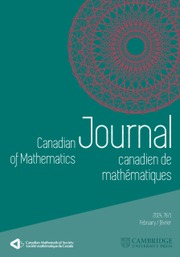Crossref Citations
This article has been cited by the following publications. This list is generated based on data provided by
Crossref.
Kemp, R. R. D.
1960.
On a Class of Non-Self-Adjoint Differential Operators.
Canadian Journal of Mathematics,
Vol. 12,
Issue. ,
p.
641.
Krall, Allan M.
1965.
A nonhomogeneous eigenfunction expansion.
Transactions of the American Mathematical Society,
Vol. 117,
Issue. 0,
p.
352.
Benzinger, Harold E
1970.
Equiconvergence for singular differential operators.
Journal of Mathematical Analysis and Applications,
Vol. 32,
Issue. 2,
p.
338.
Benzinger, Harold E.
1971.
Analytic Theory of Differential Equations.
Vol. 183,
Issue. ,
p.
23.
Murtazin, Kh. Kh.
1971.
Expansions in characteristic functions of the nonself-adjoint Schr�dinger operator.
Mathematical Notes of the Academy of Sciences of the USSR,
Vol. 9,
Issue. 3,
p.
192.
Kim, Taeboo
1973.
The adjoint of a differential-boundary operator with an integral boundary condition on a semiaxis.
Journal of Mathematical Analysis and Applications,
Vol. 44,
Issue. 2,
p.
434.
Freiling, Gerhard
1976.
Nichtselbstadjungierte Differentialoperatoren im nichtkompakten Fall.
Mathematische Zeitschrift,
Vol. 149,
Issue. 3,
p.
267.
Folland, G.B
1981.
Spectral analysis of a nonself-adjoint differential operator.
Journal of Differential Equations,
Vol. 39,
Issue. 2,
p.
151.
Olmedilla, E
1985.
Inverse scattering transform for general matrix Schrodinger operators and the related symplectic structure.
Inverse Problems,
Vol. 1,
Issue. 3,
p.
219.
Bairamov, Elgiz
Çakar, Öner
and
Krall, Allan M.
1999.
An Eigenfunction Expansion for a Quadratic Pencil of a Schrödinger Operator with Spectral Singularities.
Journal of Differential Equations,
Vol. 151,
Issue. 2,
p.
268.
Rota, Gian-Carlo
2003.
Gian-Carlo Rota on Analysis and Probability.
p.
53.
Mostafazadeh, Ali
2009.
Spectral Singularities of Complex Scattering Potentials and Infinite Reflection and Transmission Coefficients at Real Energies.
Physical Review Letters,
Vol. 102,
Issue. 22,
Longhi, Stefano
2009.
Spectral singularities in a non-Hermitian Friedrichs-Fano-Anderson model.
Physical Review B,
Vol. 80,
Issue. 16,
Guseinov, Gusein Sh
2009.
On the concept of spectral singularities.
Pramana,
Vol. 73,
Issue. 3,
p.
587.
Mostafazadeh, Ali
and
Mehri-Dehnavi, Hossein
2009.
Spectral singularities, biorthonormal systems and a two-parameter family of complex point interactions.
Journal of Physics A: Mathematical and Theoretical,
Vol. 42,
Issue. 12,
p.
125303.
Mostafazadeh, Ali
2009.
Resonance phenomenon related to spectral singularities, complex barrier potential, and resonating waveguides.
Physical Review A,
Vol. 80,
Issue. 3,
Mostafazadeh, Ali
2009.
Non-Hermitian Hamiltonians with a real spectrum and their physical applications.
Pramana,
Vol. 73,
Issue. 2,
p.
269.
Bairamov, Elgiz
Seyyidoglu, M. Seyyit
and
Zafer, Ağacik
2010.
Non‐Self‐Adjoint Singular Sturm‐Liouville Problems with Boundary Conditions Dependent on the Eigenparameter.
Abstract and Applied Analysis,
Vol. 2010,
Issue. 1,
Mostafazadeh, Ali
2011.
Spectral singularities of a general point interaction.
Journal of Physics A: Mathematical and Theoretical,
Vol. 44,
Issue. 37,
p.
375302.
Mostafazadeh, Ali
2011.
Semiclassical analysis of spectral singularities and their applications in optics.
Physical Review A,
Vol. 84,
Issue. 2,
 the differential expression l(y) = — y” + g(x)y generates a closed operator L on L2(— ∞, ∞), with domain D consisting of those functions y ∈ L2 with absolutely continuous derivatives and such that l(y) ∈ L2. The case where g(x) is real-valued has been extensively investigated and yields an expansion of any ƒ ∈ L2 in terms of the characteristic functions of L. We shall investigate the case where g is complex-valued.
the differential expression l(y) = — y” + g(x)y generates a closed operator L on L2(— ∞, ∞), with domain D consisting of those functions y ∈ L2 with absolutely continuous derivatives and such that l(y) ∈ L2. The case where g(x) is real-valued has been extensively investigated and yields an expansion of any ƒ ∈ L2 in terms of the characteristic functions of L. We shall investigate the case where g is complex-valued.
